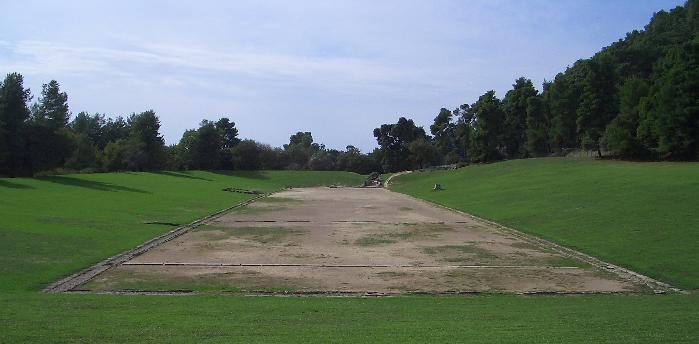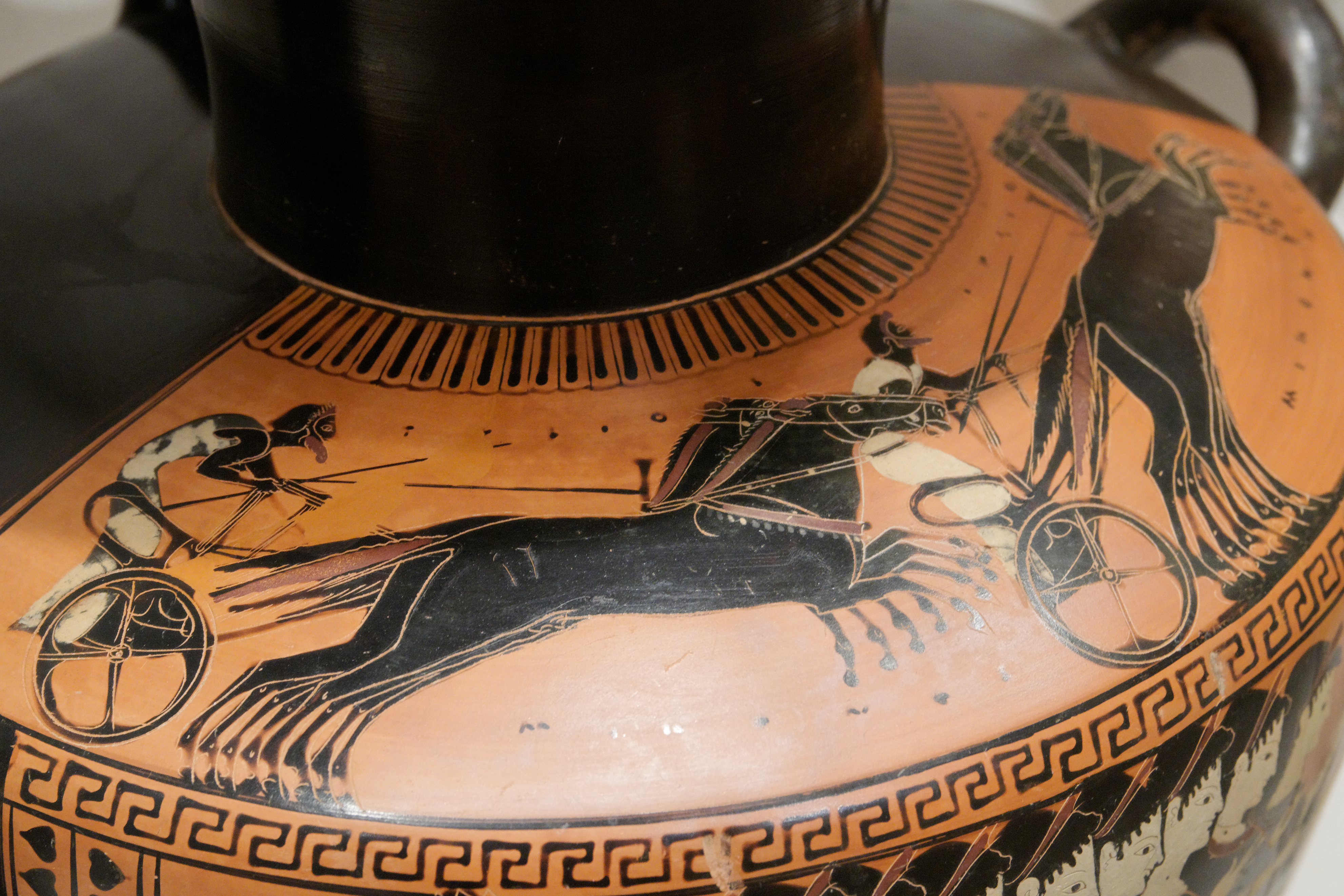|
Panathenean Games
The Panathenaic Games ( grc, Παναθήναια) were held every four years in Athens in Ancient Greece from 566 BC to the 3rd century AD. These Games incorporated religious festival, ceremony (including prize-giving), athletic competitions, and cultural events hosted within a stadium. History The Panathenaic festival was formed in order to honor the goddess Athena who had become the patron of Athens after having a competition with the god Poseidon where they were to win the favor of the Athenian people by offering the people gifts. The festival would also bring unity among the people of Athens. The attempted assassination of the tyrants Hippias and Hipparchus during the Panathenaea in 514 BC by Harmodius and Aristogeiton was often regarded as the birth of Athenian democracy. Events The competitions for which the festival came to be known were part of the Great Panathenaia, a much larger religious occasion. These ritual observances consisted of numerous sacrifices to At ... [...More Info...] [...Related Items...] OR: [Wikipedia] [Google] [Baidu] |
Greek Vase With Runners At The Panathenaic Games 530 BC
Greek may refer to: Greece Anything of, from, or related to Greece, a country in Southern Europe: *Greeks, an ethnic group. *Greek language, a branch of the Indo-European language family. **Proto-Greek language, the assumed last common ancestor of all known varieties of Greek. **Mycenaean Greek, most ancient attested form of the language (16th to 11th centuries BC). **Ancient Greek, forms of the language used c. 1000–330 BC. **Koine Greek, common form of Greek spoken and written during Classical antiquity. **Medieval Greek or Byzantine Language, language used between the Middle Ages and the Ottoman conquest of Constantinople. **Modern Greek, varieties spoken in the modern era (from 1453 AD). *Greek alphabet, script used to write the Greek language. *Greek Orthodox Church, several Churches of the Eastern Orthodox Church. *Ancient Greece, the ancient civilization before the end of Antiquity. *Old Greek, the language as spoken from Late Antiquity to around 1500 AD. Other uses *Gre ... [...More Info...] [...Related Items...] OR: [Wikipedia] [Google] [Baidu] |
Olympic Games
The modern Olympic Games or Olympics (french: link=no, Jeux olympiques) are the leading international sporting events featuring summer and winter sports competitions in which thousands of athletes from around the world participate in a variety of competitions. The Olympic Games are considered the world's foremost sports competition with more than 200 teams, representing sovereign states and territories, participating. The Olympic Games are normally held every four years, and since 1994, have alternated between the Summer and Winter Olympics every two years during the four-year period. Their creation was inspired by the ancient Olympic Games (), held in Olympia, Greece from the 8th century BC to the 4th century AD. Baron Pierre de Coubertin founded the International Olympic Committee (IOC) in 1894, leading to the first modern Games in Athens in 1896. The IOC is the governing body of the Olympic Movement (which encompasses all entities and individuals involved in the Oly ... [...More Info...] [...Related Items...] OR: [Wikipedia] [Google] [Baidu] |
Pausanias (geographer)
Pausanias ( /pɔːˈseɪniəs/; grc-gre, Παυσανίας; c. 110 – c. 180) was a Greek traveler and geographer of the second century AD. He is famous for his ''Description of Greece'' (, ), a lengthy work that describes ancient Greece from his firsthand observations. ''Description of Greece'' provides crucial information for making links between classical literature and modern archaeology. Biography Not much is known about Pausanias apart from what historians can piece together from his own writing. However, it is mostly certain that he was born c. 110 AD into a Greek family and was probably a native of Lydia in Asia Minor. From c. 150 until his death in 180, Pausanias travelled through the mainland of Greece, writing about various monuments, sacred spaces, and significant geographical sites along the way. In writing ''Description of Greece'', Pausanias sought to put together a lasting written account of "all things Greek", or ''panta ta hellenika''. Living in t ... [...More Info...] [...Related Items...] OR: [Wikipedia] [Google] [Baidu] |
Bibliotheca (Pseudo-Apollodorus)
The ''Bibliotheca'' (Ancient Greek: grc, Βιβλιοθήκη, lit=Library, translit=Bibliothēkē, label=none), also known as the ''Bibliotheca'' of Pseudo-Apollodorus, is a compendium of Greek myths and heroic legends, arranged in three books, generally dated to the first or second century AD. The author was traditionally thought to be Apollodorus of Athens, but that attribution is now regarded as false, and so "Pseudo-" was added to Apollodorus. The ''Bibliotheca'' has been called "the most valuable mythographical work that has come down from ancient times." An epigram recorded by the important intellectual Patriarch Photius I of Constantinople expressed its purpose:Victim of its own suggestions, the epigraph, ironically, does not survive in the manuscripts. For the classic examples of epitomes and encyclopedias substituting in Christian hands for the literature of Classical Antiquity itself, see Isidore of Seville's ''Etymologiae'' and Martianus Capella. It has the follo ... [...More Info...] [...Related Items...] OR: [Wikipedia] [Google] [Baidu] |
Pseudo-Apollodorus
The ''Bibliotheca'' (Ancient Greek: grc, Βιβλιοθήκη, lit=Library, translit=Bibliothēkē, label=none), also known as the ''Bibliotheca'' of Pseudo-Apollodorus, is a compendium of Greek myths and heroic legends, arranged in three books, generally dated to the first or second century AD. The author was traditionally thought to be Apollodorus of Athens, but that attribution is now regarded as false, and so "Pseudo-" was added to Apollodorus. The ''Bibliotheca'' has been called "the most valuable mythographical work that has come down from ancient times." An epigram recorded by the important intellectual Patriarch Photius I of Constantinople expressed its purpose:Victim of its own suggestions, the epigraph, ironically, does not survive in the manuscripts. For the classic examples of epitomes and encyclopedias substituting in Christian hands for the literature of Classical Antiquity itself, see Isidore of Seville's ''Etymologiae'' and Martianus Capella. It has the follo ... [...More Info...] [...Related Items...] OR: [Wikipedia] [Google] [Baidu] |
Androgeus (son Of Minos)
{{Infobox deity , type = Greek , name = Androgeus , deity_of = Prince of Crete , member_of = the Cretan Royal Family , image = , alt = , caption = , other_names = , affiliation = , cult_center = , abode = Crete , consort = , parents = Minos and Pasiphae or Crete , siblings = Catreus, Ariadne, Glaucus, Xenodice, Acacallis, Phaedra and Deucalion; the Minotaur , offspring = , predecessor = , successor = , Roman_equivalent = , Etruscan_equivalent = In Greek mythology, Androgeus or Androgeos (Ancient Greek: Ἀνδρόγεως, Latin: ''Androgeum'' or ''Androgeōs'' derived from ''andros'' "of a man" and ''geos'', genitive ''gē'' "earth, land") was a Cretan prince as the son of King Minos. Family Androgeus' mother was Pasiphaë, daughter of Helios.Apollodorus, 3.15.7 He was the brother of Acacallis, Ariadne, Deucalion, Phaedra, Glaucus, Catreus and Xenodice. Androgeus's sons were Sthenelus and Alcaeus, who later became companions of Heracles. ... [...More Info...] [...Related Items...] OR: [Wikipedia] [Google] [Baidu] |
Minos
In Greek mythology, Minos (; grc-gre, Μίνως, ) was a King of Crete, son of Zeus and Europa. Every nine years, he made King Aegeus pick seven young boys and seven young girls to be sent to Daedalus's creation, the labyrinth, to be eaten by the Minotaur. After his death, Minos became a judge of the dead in the underworld. The Minoan civilization of Crete was named after him by the archaeologist Sir Arthur Evans. Etymology "Minos" is often interpreted as the Cretan word for "king", or, by a euhemerist interpretation, the name of a particular king that was subsequently used as a title. According to La Marle's reading of Linear A, which has been heavily criticised as arbitrary, we should read ''mwi-nu ro-ja'' (Minos the king) on a Linear A tablet. La Marle suggests that the name'' mwi-nu'' (Minos) is expected to mean 'ascetic' as Sanskrit ''muni'', and fits this explanation to the legend about Minos sometimes living in caves on Crete. The royal title ''ro-ja'' is read o ... [...More Info...] [...Related Items...] OR: [Wikipedia] [Google] [Baidu] |
Minotaur
In Greek mythology, the Minotaur ( , ;. grc, ; in Latin as ''Minotaurus'' ) is a mythical creature portrayed during classical antiquity with the head and tail of a bull and the body of a man or, as described by Roman poet Ovid, a being "part man and part bull". He dwelt at the center of the Labyrinth, which was an elaborate maze-like construction designed by the architect Daedalus and his son Icarus, on the command of King Minos of Crete. The Minotaur was eventually killed by the Athenian hero Theseus. Etymology The word ''minotaur'' derives from the Ancient Greek , a compound of the name ( Minos) and the noun "bull", translated as "(the) Bull of Minos". In Crete, the Minotaur was known by the name Asterion, a name shared with Minos' foster-father. "Minotaur" was originally a proper noun in reference to this mythical figure. That is, there was only the one Minotaur. In contrast, the use of "minotaur" as a common noun to refer to members of a generic "species" of bull- ... [...More Info...] [...Related Items...] OR: [Wikipedia] [Google] [Baidu] |
Chariot Race
Chariot racing ( grc-gre, ἁρματοδρομία, harmatodromia, la, ludi circenses) was one of the most popular ancient Greek, Roman, and Byzantine sports. In Greece, chariot racing played an essential role in aristocratic funeral games from a very early time. With the institution of formal races and permanent racetracks, chariot racing was adopted by many Greek states and their religious festivals. Horses and chariots were very costly. Their ownership was a preserve of the wealthiest aristocrats, whose reputations and status benefitted from offering such extravagant, exciting displays. Their successes could be further broadcast and celebrated through commissioned odes and other poetry. In standard racing practise, each chariot held a single driver and was pulled by four horses, or sometimes two. Drivers and horses risked serious injury or death through collisions and crashes; this added to the excitement and interest for spectators. Most charioteers were slaves or contracte ... [...More Info...] [...Related Items...] OR: [Wikipedia] [Google] [Baidu] |
Panathenaic Amphora
Panathenaic amphorae were the amphorae, large ceramic vessels, that contained the olive oil given as prizes in the Panathenaic Games. Some were and high. This oil came from the sacred grove of Athena at Akademia. The amphorae which held it had the distinctive form of tight handles, narrow neck and feet, and they were decorated with consistent symbols, in a standard form using the black figure technique, and continued to be so, long after the black figure style had fallen out of fashion. Some Panathenaic amphorae depicted Athena Promachos, goddess of war, advancing between columns brandishing a spear and wearing the ''aegis'', and next to her the inscription ''"(one) of the prizes from Athens"''. On the back of the vase was a representation of the event for which it was an award. Sometimes roosters are depicted perched on top of the columns. The significance of the roosters remains a mystery. Later amphorae also had that year's archon's name written on it making finds of those ... [...More Info...] [...Related Items...] OR: [Wikipedia] [Google] [Baidu] |





